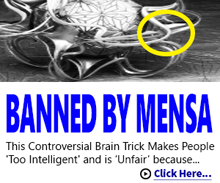 By Aaron Dykes
By Aaron Dykes
Editor’s Note by Aaron Dykes: The article below, from The Age of Transitions, is an important account of many of the key figures in the Transhumanist movement, who have played a major role in shaping the past century, and who have brought to life complex technological machines to run our lives, and merge with our functions and, eventually, our thoughts. The cybernetics movement created the technological means of achieving psychological goals of managing the masses in a collective “hive mind.” As artificial intelligence reaches a threshold for sophistication, and it is paired with a database that represents the total knowledge of world affairs, the power over the affairs of this world will be unified and centralized. Individuality will be a trifling thing, as will rights. The total power of the state can theoretically be attained, and even perpetuated indefinitely.
These themes are behind the thinking and political agendas of many groups who have steered global politics and secret society goals. There is an obscure telling of this theme in the critically rejected 1997 film Exorcist 2: The Heretic, directed by John Boorman who is notable for exploring similar themes in the 1974 revelation-of-the-method cult classic Zardoz
– a film that promises to go “Beyond 1984. Beyond 2001. Beyond Love. Beyond Death.” but instead largely misses its audience, and is known instead for the bizarre costume worn by Sean Connery and the strange, little understood plot.
Exorcist 2: The Heretic makes almost no attempt to follow up the story started in the first Exorcist, but instead departs completely from the concept. Instead, Boorman inserts the Transhumanist ideas of Pierre Teilhard de Chardin, the Jesuit priest who worked with the Rockefeller Foundation
and UNESCO
head Julian Huxley (who authored the biology text classic Evolution: The Modern Synthesis)
on a collective evolution agenda that construct a global society centered around shared ideas and communications control.
 The priest is a heretic because he abandons the traditional church doctrines about the nature of good and evil, and instead propagates a dogma for the new age of the global consciousness – where technology will transcend the traditional divisions of man’s mind and introduce the “god-like powers” of collective action and communication. Ultimately, technology reaches out a hand for man to connect with the infinite here in this plane of existence.
The priest is a heretic because he abandons the traditional church doctrines about the nature of good and evil, and instead propagates a dogma for the new age of the global consciousness – where technology will transcend the traditional divisions of man’s mind and introduce the “god-like powers” of collective action and communication. Ultimately, technology reaches out a hand for man to connect with the infinite here in this plane of existence.
Zardoz strikes a similarly misunderstood note with a fable about a group of Olympian gods-on-earth who become literally bored to death with manipulating the masses from inside their eternal hive mind group of scientists and experts. Unable to greet death, they form a death cult obsessed with formulating their own way out of the monotony they have created for themselves. One member of the group reveals the “Wizard of Oz” tricks they use to rule to Sean Connery, who plays a Brutal exterminator – a crude enforcer of the will of the false idol Zardoz. His righteous anger at learning about the men behind the curtain becomes the only way to undo the horrible hive mind running a eugenics society.
The two films are, by reputation, the worst ever made by Boorman, but there is a hidden warning encoded in both about the coming new world order system – a social hive system that will electronically and digitally control its population, who lose their individual thoughts, and instead become “empty vessels” to possession – not by the satanic demons of the original blockbuster Exorcist film – but rather by a rhythmic entrainment that makes individual people subject to the sway of the crowd. A clandestine history of mind control research – conducted under such underground mega-projects as the CIA’s MK Ultra – have unlocked the commands necessary to control both man and machine, and play the common chords between them.
The brain and computer operate parallel, and as one.
The animal in man is prodded and programmed by the computer.
The behavioral response of the cybernetic man, stimulated by the electronic signals that push the buttons of his brain’s emotional and survival response centers, unveils the transhuman vision of man.
 His future, through this alchemical marriage of machine and man, makes man more human than human.
His future, through this alchemical marriage of machine and man, makes man more human than human.
The new man works in unison with the complex needs of the machine of the state. The new man is part of a hive collective, and a collective conscience that yields to control through every communication.
His bond with other single men is only through the mediated connection of the system.
His only direct bond with the world becomes tied to the beast system itself, which can bring out the goodness and efficiency of the many hands together, or can arouse the dark and dangerous passions of the crowd mind, which will follow the beat and cues of the music, and whatever tune the piper plays.
Ultimately, the Internet, smart phones in every hand and our digital devices are linking together the underlying agenda and the present/emerging technology. The Internet of Things (IoT) and smart city/smart grid plan for the masses will put everyone at the hands of technological control.
Familiarize yourself with Pierre Teilhard de Chardin. Note that we absolutely do not endorse everything Franz writes, but the points he makes about Chardin need to be discussed and are worth posting here.
The Coming Hive Mind: The Jesuit Priest Who Influenced Transhumanism
By Aaron Franz
The Age of Transitions
First posted Friday May 1, 2009
Pierre Teilhard de Chardin lived from 1881-1955. He was a Jesuit priest, philosopher and paleontologist. Through the study and practice of these three supposedly separate disciplines he developed ideas which are just now starting to be advocated by Transhumanists. The relationship between religion, philosophy and science has been distorted in modern times. The truth is that all three are part of one over-arching force. Teilhard obviously was well aware of this.
 Teilhard took the scientific concept of evolution and applied it to the Christian notion of spiritual rapture. He believed that technology was the tool which would bring about the ultimate spiritual evolution of mankind. According to him, this is the work of Christ.
Teilhard took the scientific concept of evolution and applied it to the Christian notion of spiritual rapture. He believed that technology was the tool which would bring about the ultimate spiritual evolution of mankind. According to him, this is the work of Christ.
Interestingly Teilhard’s beliefs also reconcile panpsychism with Christianity. Panpsychism is traditionally thought of as a pagan belief. It is the idea that all matter is intelligent (to varying degrees.) This intelligence also translates to consciousness. All material in our world is therefore “alive”, as it possesses consciousness. Panpsychism is also known as pantheism. From this standpoint the entire Earth is seen as a living organism. Teilhard developed an Omega Point Theory, which posits that all the organisms on Earth will reach a higher evolutionary point by merging together into one unified consciousness, a “planetized spirit.”
Before the entire planet can evolve into one being, first humans have to merge their collective intelligence into one super-mind. The medium of realizing this is computational technology. Technology itself was seen as a living thing to Teilhard. Its nervous system would eventually cover the globe. Many see this as a prediction of today’s internet. He called this the “technosphere”, which would grow in intelligence by learning from all those who contributed their knowledge to it’s global database. This would be:
the manifestation of a kind of super-brain, capable of attaining mastery over some supersphere in the universe.
This is Teilhard’s conception of a hive mind. He saw the merge of mankind and technology as a necessary first step in the collective evolution of the universe. This natural evolution is brought about by the deliberate scientific use of man’s intelligence. Teilhard was well aware that this was a eugenic notion, and had no problem talking about it:
So far we have certainly allowed our race to develop at random, and we have given too little thought to the question of what medical and moral factors must replace the crude forces of natural selection should we suppress them. In the course of the coming centuries it is indispensable that a nobly human form of eugenics, on a standard worthy of our personalities, should be discovered and developed. Eugenics applied to individuals leads to eugenics applied to society.
Materialistic science is but a means to reach our ultimate spiritual redemption. As a member of the Society of Jesus, this is the driving force behind Teilhard’s work. By merging human consciousness with that of the “technosphere” we can reach new spiritual heights. Within the physical machine lies that intangible spiritual nature which remains unseen, but is the guiding force behind the actual operation of the machine. This will facilitate man’s “translation” into a spiritual superman, a “trans-human.” We will: “break through the material framework of time and space” and enter the “pleroma.” The “pleroma” is that spiritual realm within the overarching technosphere that will allow us to recreate our past physical existence through digital simulation. This is Teilhard’s conception of the rapture, the way in which we will all be “born again.”
 Laughing all of this off was much easier to do while Teilhard was still alive. At that time computers were a completely new thing. The idea of using one in your house would have been seen as a radical idea. No one was ready to hear about Omega Point Theory. Even today these ideas are pure science fiction to most people, but reality seems to be pointing toward the creation of radical technologies which could very well facilitate these kinds of miracles. We certainly should not disregard them as pure fantasy.
Laughing all of this off was much easier to do while Teilhard was still alive. At that time computers were a completely new thing. The idea of using one in your house would have been seen as a radical idea. No one was ready to hear about Omega Point Theory. Even today these ideas are pure science fiction to most people, but reality seems to be pointing toward the creation of radical technologies which could very well facilitate these kinds of miracles. We certainly should not disregard them as pure fantasy.
It is very telling that Teilhard practiced Christianity, paleontology, philosophy, and also advocated eugenics. He had no problem merging these ideas. He believed in a coming egalitarian world government. He saw everything as being interconnected. His ideas are only now making their way into the mainstream as the dawning of the new age approaches. We are all being told that we live in “One World” as the virtues of “global citizenship” are being preached from the highest pulpits. Although the wonders of converging technology haven’t been fully disclosed to the public as of yet, they will be in due time. The old social paradigms are being steadily eroded as each generation’s world-view evolves into something that would have been unthinkable to their forebears. This is the way in which humanity “evolves.” This process is much larger than you or me. It is something worth thinking about for anybody who truly wants to make a difference in this world.
The mental trap of labeling Teilhard a religious nut, or on the other side of the coin, a materialistic non-believer doesn’t work. There are closed minded people on both sides of this fence that need to open their minds to the bigger picture. Our collective future depends upon our ability to grow up intellectually, to start seeing things as they truly are, and not how we want them to be. I don’t agree with Teilhard’s philosophy, but that doesn’t mean that I disregard what he says. There is important truth to be found by reading between the lines.
Here’s a pretty good overview of the rise and fall of the hive mind:
Aaron Dykes is a co-founder of TruthstreamMedia.com. As a writer, researcher and video producer who has worked on numerous documentaries and investigative reports, he uses history as a guide to decode current events, uncover obscure agendas and contrast them with the dignity afforded individuals as recognized in documents like the Bill of Rights.

Soylent Green is people?